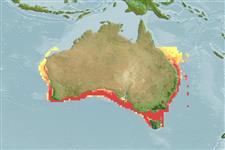Common names from other countries
Classification / Names / Names
Namen | Synonyme | Catalog of Fishes (gen., sp.) | ITIS | CoL | WoRMS
Environment: milieu / climate zone / depth range / distribution range
Ökologie
; tiefenbereich 0 - 700 m (Ref. 275), usually 50 - 300 m (Ref. 8121). Subtropical; 19°S - 43°S, 109°E - 157°E (Ref. 275)
Indo-West Pacific: Australia and New Zealand. Subtropical to temperate.
Length at first maturity / Size / Gewicht / Alter
Maturity: Lm ? range ? - ? cm Max length : 35.0 cm ML Männchen/unbestimmt; (Ref. 275); 40 cm ML (female); max. veröff. Gewicht: 800.00 g (Ref. 275)
Females grow larger than males (Ref. 3722). Maximum depth from Ref. 8121. Minimum common depth from Ref. 121690. Neritic and oceanic species (Ref. 121690). Mostly inhabits waters <500 m in depth on the continental shelf and slope (Ref. 121690). Common in the continental shelf and sometimes can even enter shallow waters and estuaries, particularly during summer (Ref. 121673). Most abundant near the shelf-break front or where other mesoscale oceanographic activity is present. Mature squid may be restricted to deeper offshore waters for successful spawning (Ref. 121689). Feeds on ommastrephid squids, fishes (primarily pilchards; Ref. 275).
Life cycle and mating behavior
Geschlechtsreife | Fortpflanzung | Ablaichen | Eier | Fecundity | Larven
Members of the class Cephalopoda are gonochoric. Male and female adults usually die shortly after spawning and brooding, respectively. Mating behavior: Males perform various displays to attract potential females for copulation. During copulation, male grasp the female and inserts the hectocotylus into the female's mantle cavity where fertilization usually occurs. Life cycle: Embryos hatch into planktonic stage and live for some time before they grow larger and take up a benthic existence as adults.
Roper, C.F.E., M.J. Sweeney and C.E. Nauen. 1984. (Ref. 275)
IUCN Rote Liste Status (Ref. 130435)
CITES Status (Ref. 108899)
Not Evaluated
Not Evaluated
Nutzung durch Menschen
Fischereien: kommerziell
| FishSource |
Tools
Mehr Information
Alter/Größe
Wachstum
Länge-Gewicht
Länge-Länge
Morphologie
Larven
Dichte
Internet Quellen
Estimates based on models
Preferred temperature
(Ref.
115969): 13.7 - 21.2, mean 15.9 (based on 106 cells).
Verwundbarkeit
Low vulnerability (25 of 100).
